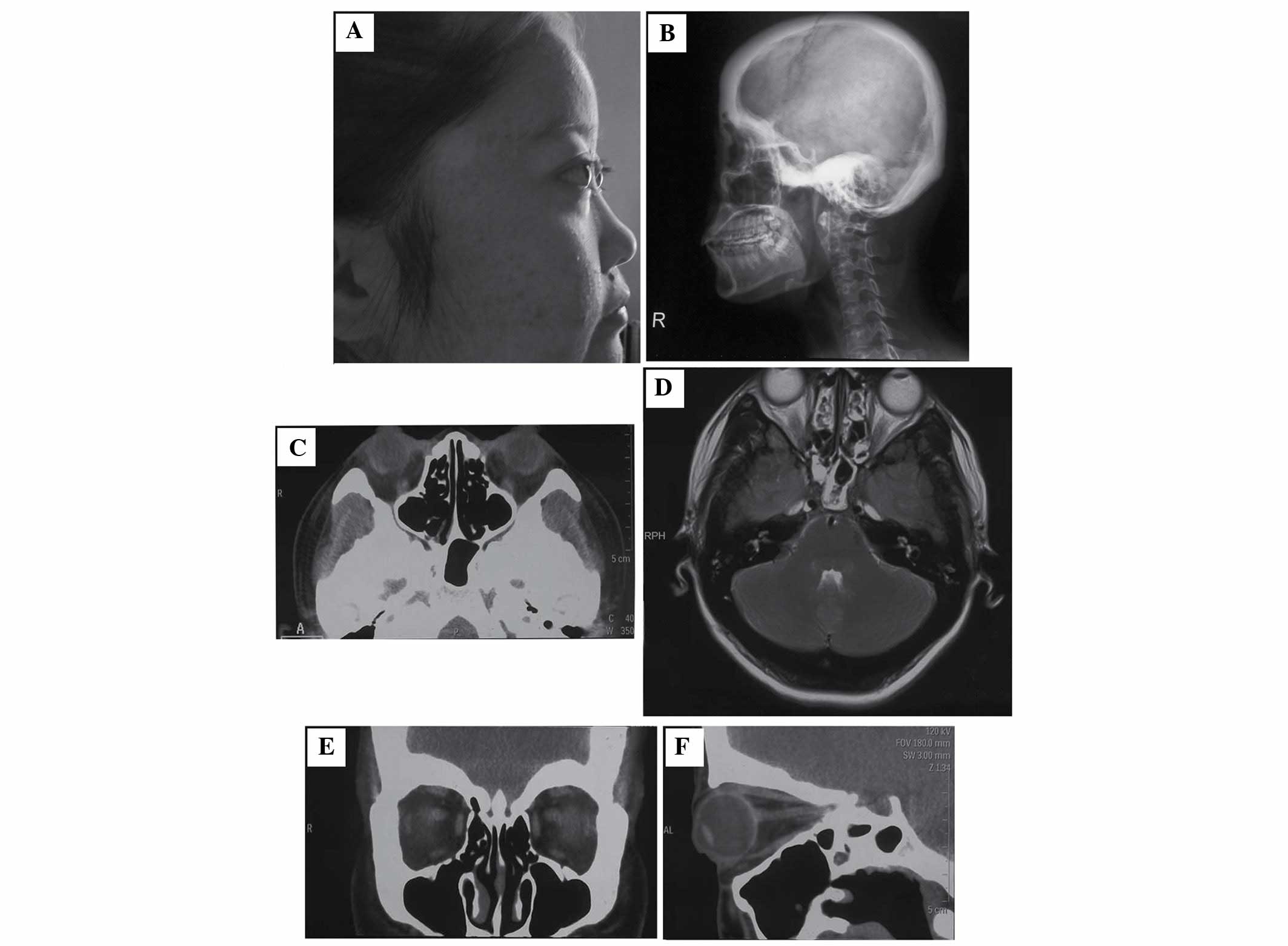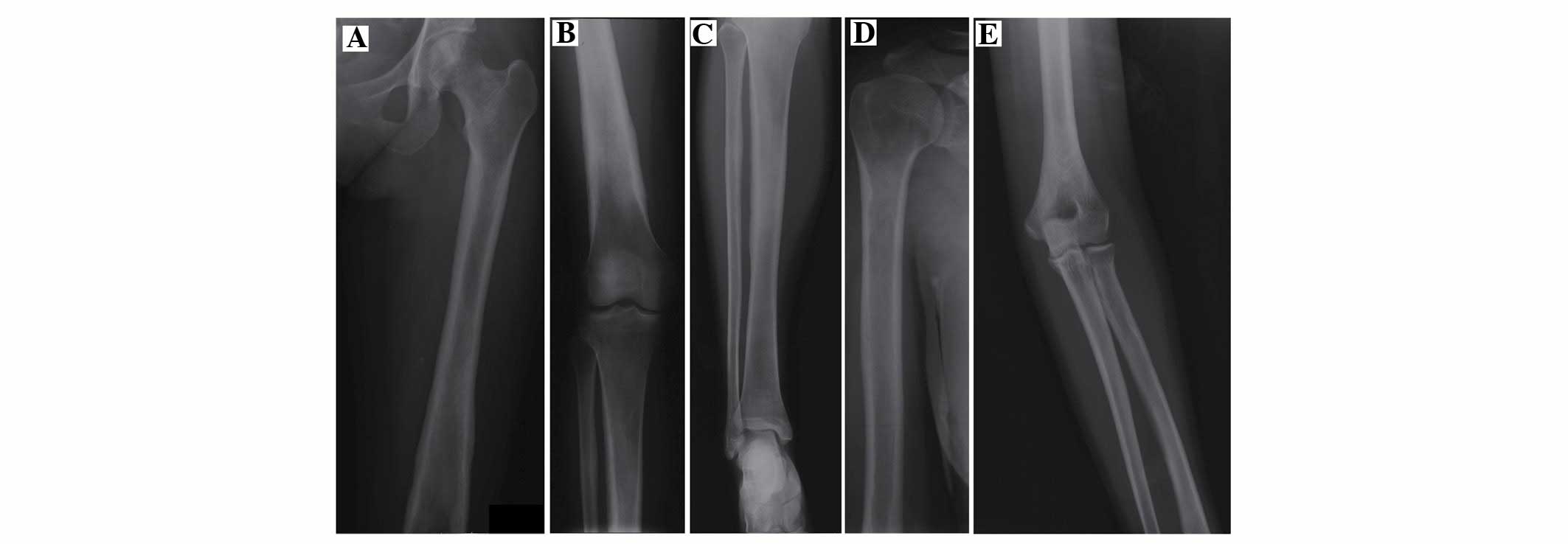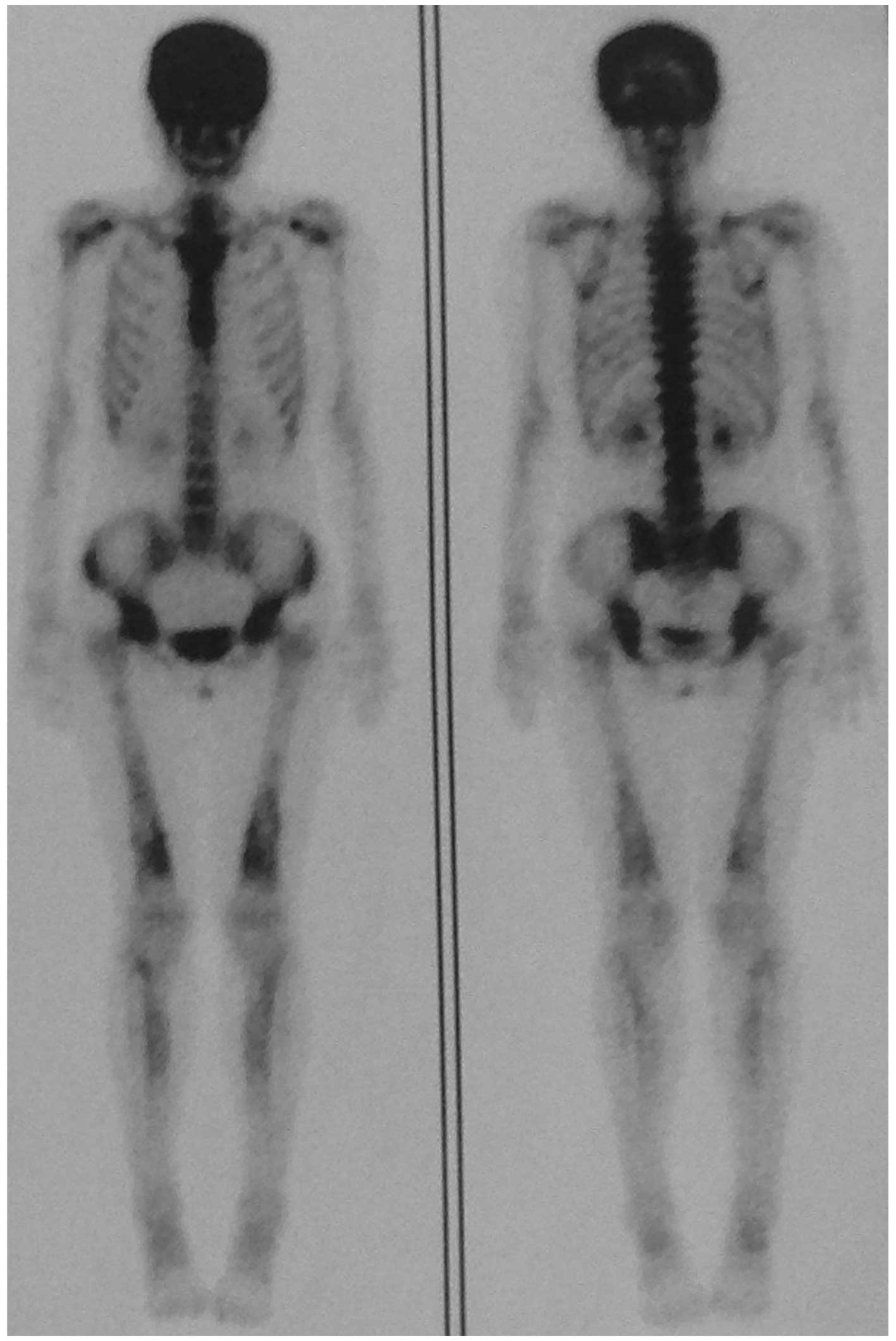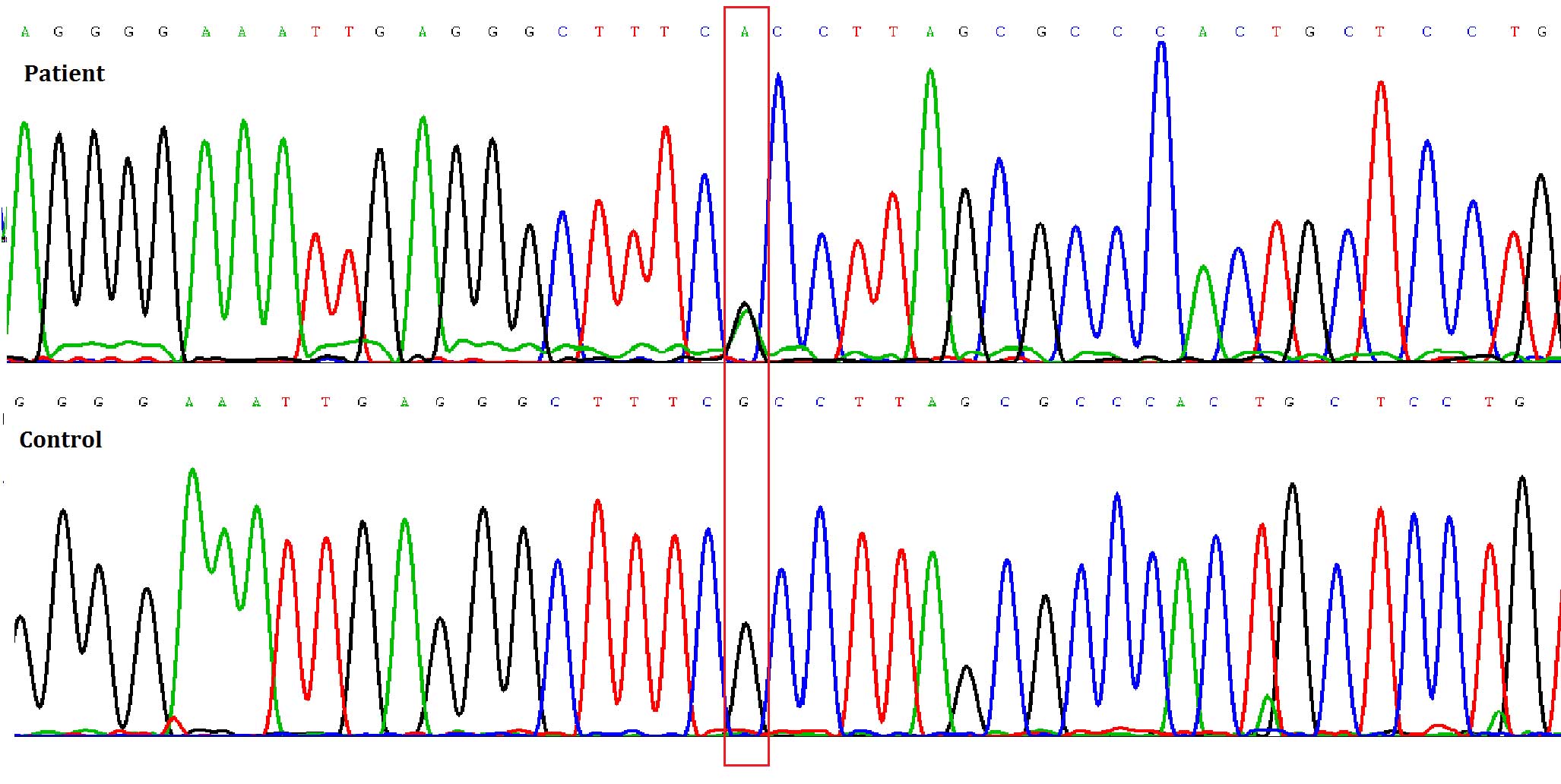|
1
|
Janssens K, Gershoni-Baruch R, Van Hul E,
Brik R, Guañabens N, Migone N, Verbruggen LA, Ralston SH, Bonduelle
M, Van Maldergem L, et al: Localisation of the gene causing
diaphyseal dysplasia Camurati-Engelmann to chromosome 19q13. J Med
Genet. 37:245–249. 2000. View Article : Google Scholar : PubMed/NCBI
|
|
2
|
Janssens K, Gershoni-Baruch R, Guañabens
N, Migone N, Ralston S, Bonduelle M, Lissens W, Van Maldergem L,
Vanhoenacker F, Verbruggen L and Van Hul W: Mutations in the gene
encoding the latency-associated peptide of TGF-beta 1 cause
Camurati-Engelmann disease. Nat Genet. 26:273–275. 2000. View Article : Google Scholar : PubMed/NCBI
|
|
3
|
Kinoshita A, Saito T, Tomita H, Makita Y,
Yoshida K, Ghadami M, Yamada K, Kondo S, Ikegawa S, Nishimura G, et
al: Domain-specific mutations in TGFB1 result in Camurati-Engelmann
disease. Nat Genet. 26:19–20. 2000. View
Article : Google Scholar : PubMed/NCBI
|
|
4
|
Janssens K, Vanhoenacker F, Bonduelle M,
Verbruggen L, Van Maldergem L, Ralston S, Guañabens N, Migone N,
Wientroub S, Divizia MT, et al: Camurati-Engelmann disease: Review
of the clinical, radiological, and molecular data of 24 families
and implications for diagnosis and treatment. J Med Genet. 43:1–11.
2006. View Article : Google Scholar
|
|
5
|
Sparkes RS and Graham CB:
Camurati-Engelmann disease. Genetics and clinical manifestations
with a review of the literature. J Med Genet. 9:73–85. 1972.
View Article : Google Scholar : PubMed/NCBI
|
|
6
|
Carlson ML, Beatty CW, Neff BA, Link MJ
and Driscoll CL: Skull base manifestations of Camurati-Engelmann
disease. Arch Otolaryngol Head Neck Surg. 136:566–575. 2010.
View Article : Google Scholar : PubMed/NCBI
|
|
7
|
Campos-Xavier B, Saraiva JM, Savarirayan
R, Verloes A, Feingold J, Faivre L, Munnich A, Le Merrer M and
Cormier-Daire V: Phenotypic variability at the TGF-beta1 locus in
Camurati-Engelmann disease. Hum Genet. 109:653–658. 2001.
View Article : Google Scholar
|
|
8
|
Smith R, Walton RJ, Corner BD and Gordon
IR: Clinical and biochemical studies in Engelmann's disease
(progressive diaphyseal dysplasia). Q J Med. 46:273–294.
1977.PubMed/NCBI
|
|
9
|
Hernández MV, Peris P, Guañabens N,
Alvarez L, Monegal A, Pons F, Ponce A and Muñoz-Gómez J:
Biochemical markers of bone turnover in Camurati-Engelmann disease:
A report on four cases in one family. Calcif Tissue Int. 61:48–51.
1997. View Article : Google Scholar : PubMed/NCBI
|
|
10
|
Wu XP, Yang YH, Zhang H, Yuan LQ, Luo XH,
Cao XZ and Liao EY: Gender differences in bone density at different
skeletal sites of acquisition with age in Chinese children and
adolescents. J Bone Miner Metab. 23:253–260. 2005. View Article : Google Scholar : PubMed/NCBI
|
|
11
|
Janssens K, ten Dijke P, Ralston SH,
Bergmann C and Van Hul W: Transforming growth factor-beta 1
mutations in Camurati-Engelmann disease lead to increased signaling
by altering either activation or secretion of the mutant protein. J
Biol Chem. 278:7718–7724. 2003. View Article : Google Scholar
|
|
12
|
Oklü R and Hesketh R: The latent
transforming growth factor beta binding protein (LTBP) family.
Biochem J. 352(Pt 3): 601–610. 2000. View Article : Google Scholar : PubMed/NCBI
|
|
13
|
Pedrozo HA, Schwartz Z, Mokeyev T, Ornoy
A, Xin-Sheng W, Bonewald LF, Dean DD and Boyan BD: Vitamin D3
metabolites regulate LTBP1 and latent TGF-beta1 expression and
latent TGF-beta1 incorporation in the extracellular matrix of
chondrocytes. J Cell Biochem. 72:151–165. 1999. View Article : Google Scholar : PubMed/NCBI
|
|
14
|
Bonewald LF, Wakefield L, Oreffo RO,
Escobedo A, Twardzik DR and Mundy GR: Latent forms of transforming
growth factor-beta (TGF beta) derived from bone cultures:
Identification of a naturally occurring 100-kDa complex with
similarity to recombinant latent TGF beta. Mol Endocrinol.
5:741–751. 1991. View Article : Google Scholar : PubMed/NCBI
|
|
15
|
Wu S, Liang S, Yan Y, Wang Y, Li F, Deng
Y, Huang W, Yuan W, Luo N, Zhu C, et al: A novel mutation of TGF
beta1 in a Chinese family with Camurati-Engelmann disease. Bone.
40:1630–1634. 2007. View Article : Google Scholar : PubMed/NCBI
|
|
16
|
Whyte MP, Totty WG, Novack DV, Zhang X,
Wenkert D and Mumm S: Camurati-Engelmann disease: Unique variant
featuring a novel mutation in TGFβ1 encoding transforming growth
factor beta 1 and a missense change in TNFSF11 encoding RANK
ligand. J Bone Miner Res. 26:920–933. 2011. View Article : Google Scholar : PubMed/NCBI
|
|
17
|
Saito T, Kinoshita A, Yoshiura Ki, Makita
Y, Wakui K, Honke K, Niikawa N and Taniguchi N: Domain-specific
mutations of a transforming growth factor (TGF)-beta 1
latency-associated peptide cause Camurati-Engelmann disease because
of the formation of a constitutively active form of TGF-beta 1. J
Biol Chem. 276:11469–11472. 2001. View Article : Google Scholar : PubMed/NCBI
|
|
18
|
Janssens K, ten Dijke P, Janssens S and
Van Hul W: Transforming growth factor-beta1 to the bone. Endocr
Rev. 26:743–774. 2005. View Article : Google Scholar : PubMed/NCBI
|
|
19
|
Wang C, Zhang BH, Liu YJ, Hu YQ, He JW and
Zhang ZL: Transforming growth factor-β1 gene mutations and
phenotypes in pediatric patients with Camurati-Engelmann disease.
Mol Med Rep. 7:1695–1699. 2013.PubMed/NCBI
|
|
20
|
McGowan NW, MacPherson H, Janssens K, Van
Hul W, Frith JC, Fraser WD, Ralston SH and Helfrich MH: A mutation
affecting the latency-associated peptide of TGFbeta1 in
Camurati-Engelmann disease enhances osteoclast formation in vitro.
J Clin Endocrinol Metab. 88:3321–3326. 2003. View Article : Google Scholar : PubMed/NCBI
|
|
21
|
Crisp AJ and Brenton DP: Engelmann's
disease of bone - a systemic disorder? Ann Rheum Dis. 41:183–188.
1982. View Article : Google Scholar : PubMed/NCBI
|
|
22
|
Gupta S and Cheikh IE: Camurati-Engelmann
disease in conjunction with hypogonadism. Endocr Pract. 11:399–407.
2005. View Article : Google Scholar
|
|
23
|
Meczekalski B, Czyzyk A, Podfigurna-Stopa
A, Rydzewski B, Sroczynski J, Lipinska M, Sokalski J, Krawczynski
M, Jamsheer A, Katulski K and Genazzani A: Hypothalamic amenorrhea
in a Camurati-Engelmann disease - a case report. Gynecol
Endocrinol. 29:511–514. 2013. View Article : Google Scholar : PubMed/NCBI
|
|
24
|
Massagué J, Cheifetz S, Endo T and
Nadal-Ginard B: Type beta transforming growth factor is an
inhibitor of myogenic differentiation. Proc Natl Acad Sci USA.
83:8206–8210. 1986. View Article : Google Scholar : PubMed/NCBI
|
|
25
|
Ignotz RA and Massagué J: Type beta
transforming growth factor controls the adipogenic differentiation
of 3T3 fibroblasts. Proc Natl Acad Sci USA. 82:8530–8534. 1985.
View Article : Google Scholar : PubMed/NCBI
|
|
26
|
Saraiva JM: Progressive diaphyseal
dysplasia: A three-generation family with markedly variable
expressivity. Am J Med Genet. 71:348–352. 1997. View Article : Google Scholar : PubMed/NCBI
|
|
27
|
Liang YH, Li W, Li LY, Ye YY and Lu GX: A
mutation in TGF beta1 gene encoding the latency-associated peptide
in a Chinese patient with Camurati-Engelmann disease. Zhonghua Yi
Xue Yi Chuan Xue Za Zhi. 23:502–504. 2006.PubMed/NCBI
|
|
28
|
Park SJ, Yoon CS, Park HW, Choi JR, Chung
JS and Lee KA: The first Korean case of Camurati-Engelmann disease
(progressive diaphyseal dysplasia) confirmed by TGFB1 gene mutation
analysis. J Korean Med Sci. 24:737–740. 2009. View Article : Google Scholar : PubMed/NCBI
|
|
29
|
Bhadada SK, Sridhar S, Steenackers E,
Dhiman V, Mortier G, Bhansali A and Van Hul W: Camurati-Engelmann
disease (progressive diaphyseal dysplasia): Reports of an Indian
kindred. Calcif Tissue Int. 94:240–247. 2014. View Article : Google Scholar
|
|
30
|
Wallace SE, Lachman RS, Mekikian PB, Bui
KK and Wilcox WR: Marked phenotypic variability in progressive
diaphyseal dysplasia (Camurati-Engelmann disease): Report of a
four-generation pedigree, identification of a mutation in TGFB1,
and review. Am J Med Genet A. 129A:235–247. 2004. View Article : Google Scholar : PubMed/NCBI
|













